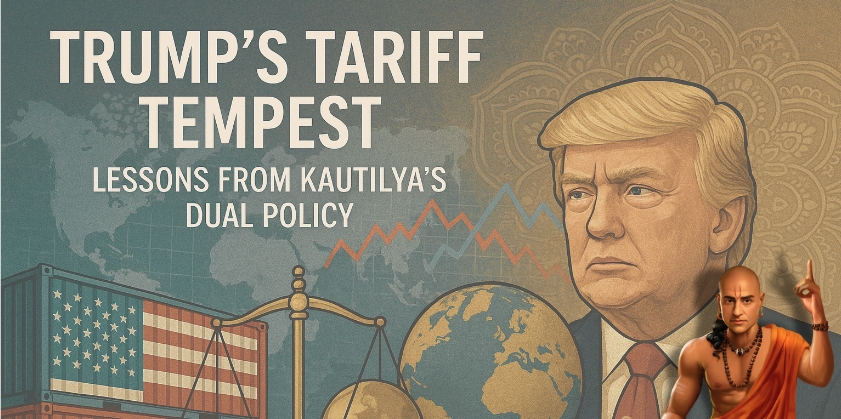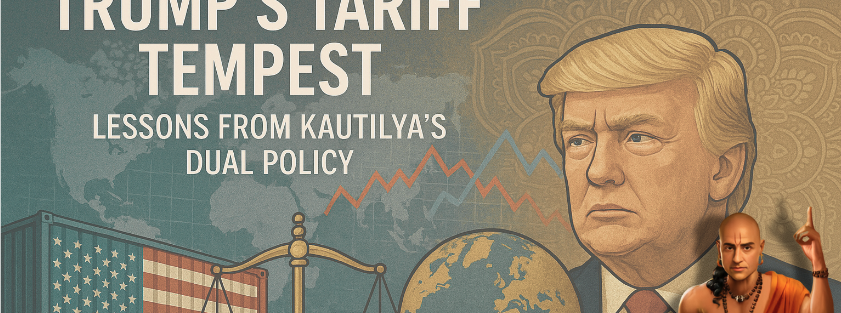
Introduction: Ancient Wisdom for Modern Trade Wars
In an era of escalating trade tensions and economic brinkmanship, the principles of Kautilya’s Arthashastra offer timeless insights into navigating complex geopolitical landscapes. Chapter 7, Book 7 of the Arthashastra, titled “Peace and War Connected with the Dual Policy,” introduces the concept of द्वैधीभाव (dvaidhibhava)—a dual strategy of balancing संधि (sandhi) – Peace and विग्रह (vigraha) – Conflict. This framework is as relevant today as it was in ancient India, particularly in understanding modern trade wars, such as those initiated by U.S. President Donald Trump.
Trump’s tariff policies, including the standoff with China, can be analysed through the lens of Kautilyan statecraft. Similarly, India’s strategic response to global trade realignments reflects a nuanced application of द्वैधीभाव (dvaidhibhava), blending diplomacy with self-strengthening measures.
Kautilya’s द्वैधीभाव (Dvaidhibhava): The Dual Policy
Kautilya’s द्वैधीभाव (dvaidhibhava) emphasizes the simultaneous pursuit of peace and preparedness for conflict. As he states, शक्त्यानुसार दान (Shaktyanusara dana)— gifts or concessions should be made based on relative power dynamics. This principle underpins his broader strategy of adapting to circumstances while maintaining long-term objectives.
The dual policy operates through four key tools:
- साम – Sama (conciliation through diplomacy)
- दान – Dana (offering gifts or concessions)
- भेद – Bheda (creating dissension among adversaries)
- दण्ड – Danda (use of force or punishment)
Kautilya advises rulers to evaluate their relative strength before choosing between peace and war, noting that शक्तिकाले हि परित्यागो निष्फलम् (Shaktikale hi parityago nishphalam)—concessions made from a position of weakness are fruitless.
The Modern मण्डल (Mandal): Trump’s Tariff Wars
The trade policies initiated under the Trump administration exemplify a modern application of द्वैधीभाव (dvaidhibhava). By imposing tariffs, the U.S. executed a form of economic दण्ड – (danda) – punishment to leverage its market power. This approach aligns with Kautilya’s assertion that power must occasionally be demonstrated to maintain credibility in negotiations.
The pattern of selective tariffs against different nations mirrors what Kautilya describes in his मण्डल (mandala) theory of interstate relations. Just as Kautilya advises treating each neighbouring state differently based on its power and intentions, the Trump administration applied varied pressure tactics according to specific bilateral power dynamics.
The ongoing tariffs on Chinese goods represent a sustained application of दण्ड – (danda), while the temporary 90-day pauses offered to other nations reflect tactical applications of साम – (Sama) conciliation.
Temporary Pause: Strategic Sama or Tactical Retreat?
Kautilya would interpret the 90-day pauses in tariffs not as weakness but as कालतः संधि – (kalatah sandhi) – a temporary peace designed to serve strategic ends. For Kautilya, काल (kala) – timing is essential in statecraft. The selective relaxation of pressure allows for recalibration while maintaining the fundamental bargaining position.
As Kautilya notes: षाड्गुण्यानुसार संधि (shadgunyanusara sandhi) – “A king shall make a peace which would enable him to build up his power in the future”. The temporary nature of these pauses allows for new negotiating dynamics while preserving the threat of renewed economic pressure – a quintessential application of द्वैधीभाव (dvaidhibhava).
China Strategy: Sustained विग्रह (vigraha)
The continued application of tariffs against China represents what Kautilya would term विग्रह (vigraha) – controlled hostility. This approach follows Kautilya’s principle that pressure must be sustained against powerful rivals until favourable terms are secured. The strategy of maintaining economic pressure while pursuing negotiations exemplifies Kautilya’s advice that दण्डः प्रणिपातकः (dandah pranipatakah) – force brings compliance.
China’s counter-tariffs and the resulting economic tension demonstrate the modern equivalent of what Kautilya described as the inevitable response to the application of दण्ड (Danda) – either submission or counter-force.
मण्डल (Mandala) Theory in Action
One of the principle of Kautilya’s मण्डल (mandala) theory says: “the neighbour is an enemy, and the neighbour’s neighbour is a friend” — is evident in Trump’s approach to alliances. While pressuring immediate trade partners like Canada and Mexico, the U.S. sought closer ties with nations like India, Isreal and Japan to counterbalance China’s influence.
India’s Strategic Response: A Kautilyan Approach
India’s response to global trade realignments demonstrates an intuitive application of द्वैधीभाव (dvaidhibhava). Amidst U.S.-China tensions, India has pursued a balanced strategy that includes:
- Strengthening Internal Capabilities: Initiatives like “Make in India” align with Kautilya’s emphasis on आत्मशक्ति वृद्धि (atmashakti vriddhi) – self-reliance. As he notes, स्वामिनः शक्तिः आत्मसम्पदः (Svaminah shaktir atmasampadah) — the ruler’s strength lies in self-sufficiency.
- Selective Engagement: India has engaged in bilateral trade negotiations with both the U.S. and China while expanding partnerships with ASEAN nations, Russia, Japan and the rest of the world. This reflects Kautilya’s advice to maintain flexibility in alliances based on shifting power dynamics.
- Differentiated Strategy: By treating each trading partner uniquely, India follows Kautilya’s principle of व्यवहार भेद (Vyavahara bheda) — differentiated treatment according to context.
- Leveraging Neutrality: India’s neutral stance in the U.S.-China trade war mirrors Kautilya’s concept of आसन (asana) – strategic neutrality, allowing it to avoid entanglement while benefiting from shifting supply chains.
Conclusion: Eternal Relevance of Arthashastra
The principles outlined in Chapter 7 of Book 7 of the Arthashastra provide a robust framework for understanding modern trade dynamics. The interplay between Trump’s tariffs, China’s countermeasures, and India’s strategic positioning underscores the timeless relevance of Kautilyan statecraft.
For India, the path forward lies in embracing द्वैधीभाव (dvaidhibhava), balancing diplomacy with economic assertiveness. By doing so, it can navigate global uncertainties while securing its long-term interests—a strategy that would make Kautilya proud.
In these turbulent times, his words resonate deeply: यथा शक्ति तथा कर्म (Yatha shakti tatha karma)—actions should align with one’s strength.




4 Comments
Malathi Shriyan
Let me e-examine your perspective through the lens of Kautilya’s Arthashastra, incorporating the dynamics of dominant nations and their relationships with weaker nations.
Dominance and Exploitation:
Kautilya’s concept of दण्ड (danda) – force or punishment, can be applied to the actions of dominant nations like America and China. They use their शक्ति (shakti) – power, to influence weaker nations, often through financial dependency, creating a form of पारतंत्र्य (paratantrya) – dependence.
Financial Dependency:
This dependency can lead to a loss of स्वातंत्र्य (svatantrya) – independence, for the weaker nation. Kautilya would caution against such relationships, advising nations to maintain आत्मशक्ति वृद्धि (atmashakti vriddhi) – self-reliance, to avoid being exploited.
Strategic Alliances:
In this context, India’s approach to forming strategic alliances with other nations, while maintaining its स्वातंत्र्य (svatantrya) – independence, can be seen as a wise application of Kautilya’s principles. By diversifying its partnerships and strengthening its internal capabilities, India can reduce its dependence on any single dominant nation.
Make in India and Self-Reliance:
India’s “Make in India” initiative aligns with Kautilya’s emphasis on आत्मशक्ति वृद्धि (atmashakti vriddhi) – self-reliance. By promoting domestic manufacturing and reducing reliance on foreign goods, India can strengthen its economic independence and reduce the influence of dominant nations.
Vaccine Diplomacy:
India’s vaccine diplomacy, where it delivered vaccines to other countries, demonstrates its commitment to दान (dana) – charity and cooperation. This approach can be seen as a strategic application of Kautilya’s principles, where India uses its शक्ति (shakti) – power, to build relationships and influence other nations.
Conclusion:
In conclusion, the dynamics between dominant nations like America and China, and weaker nations, can be understood through the lens of Kautilya’s Arthashastra. By applying Kautilya’s principles, nations like India can navigate these complex relationships, maintain their independence, and promote their own interests.
As Kautilya would say:
“स्वातंत्र्यं परमं सुखम्”
“True happiness lies in independence.”
And:
“आत्मशक्ति वृद्धिर्नाम स्वामिनः शक्तिः”
“The strength of the ruler lies in self-reliance.”
And finally, Force and a Rod, may perhaps bend the other, but usually leads to revolt. However, Love, Acceptance, Respect and Brotherhood… Wins Heart’s and makes even Enemies as Friends!
XnlWdBPpGyYoMkSo
CJApZSuyscPWkJaK
92cocoa
Heard good things about 92cocoa and finally tried it. Not bad at all! Some fun games to kill time. Check them out 92cocoa.
188bet download
Looking for the 188bet download? cachvao188bet.net got me covered. Quick and easy download, no messing around. Download it here: 188bet download